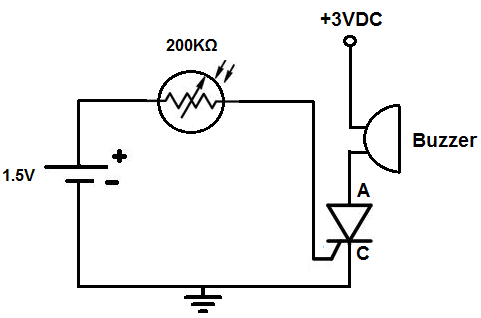
Light Alarm Circuit

This circuit activates an alarm when it detects a specific level of light. When the light exposure increases beyond a predetermined threshold, a loud buzzer sounds, providing an alert. The alarm remains inactive in low-light conditions but triggers in bright light, such as sunlight or indoor lighting. A practical application for this circuit is in securing a dark space, like a cabinet drawer containing valuables, such as jewelry. When the drawer is closed, the circuit remains in darkness and does not activate. However, if someone opens the drawer and exposes it to light, either during the day or by using a flashlight at night, the circuit triggers the alarm, alerting the homeowner of a potential intrusion. The circuit utilizes a 200kΩ photoresistor, also known as a light-dependent resistor (LDR). If a 200kΩ photoresistor is unavailable, any photoresistor with a dark resistance of 100kΩ or higher can be used. A photoresistor's resistance varies based on light exposure; it exhibits high resistance in darkness and low resistance in bright light. For instance, a 200kΩ photoresistor will have a resistance of approximately 200kΩ in total darkness. As light intensity increases, its resistance decreases significantly. The datasheet for the photoresistor will indicate its resistance at a specific illuminance level, typically around 10 lux. This characteristic makes the photoresistor an effective light sensor. In dark conditions, the high resistance prevents current from flowing through the circuit, keeping it inactive. Conversely, when exposed to light, the resistance drops, allowing current to flow and activating the electronic components. The circuit employs a silicon-controlled rectifier (SCR) as a switching device. When the SCR receives sufficient voltage at its gate terminal, it conducts current between the anode and cathode. Unlike a transistor, which requires continuous voltage at its base to remain conductive, the SCR remains on once triggered, functioning like a latching circuit. The photoresistor connects to the SCR's gate, and when light intensity reaches a certain level, the resistance drops, allowing current to trigger the SCR. This action activates the load connected to the SCR, such as a buzzer or LED. In low-light conditions, the photoresistor's resistance remains high, preventing current flow and SCR activation. However, exposure to significant light reduces the resistance, enabling current to trigger the SCR and activate the buzzer. Once triggered, the SCR stays on, functioning as an alarm. Variations of this circuit can be implemented; for instance, replacing the buzzer with an LED requires the addition of a current-limiting resistor of approximately 200Ω to 400Ω. The circuit can be customized to activate any desired device upon SCR triggering. Additionally, a version of this circuit that activates both an LED and a buzzer simultaneously is available, where the buzzer is connected in parallel with the LED.This is a circuit that will go off once it detects a certain amount of light. Once the light the circuit is exposed to increases to a certain level, a loud buzzer will go off, alerting us to this. So the alarm will not go off when the circuit is exposed to a darkly lit area but if taken out and exposed to bright light like of sunlight or the light
of a room will go off. An example of where we could use this circuit is in the following real-world example. We could place this device in a very dark area such as the drawer of a cabinet. Let`s say we have a lot of valuables which we want to protect in a chester drawer such as jewelry. And we regularly keep this drawer closed. Being closed, no light enters and the circuit is in enclosed in a dark area with no light. Under these conditions, the alarm does not go off because it is not exposed to light. However, say, if a thief breaks into the house and opens this drawer either during the day or at a night, shining a flashlight into the drawer. Now exposed to light, the circuit will trigger and buzz an alarm. So the housekeeper can know if someone has broken in by hearing this device. This one possible application of this light alarm circuit we will build. What we will use for this circuit is a 200KG photoresistor. Photoresistors are also called light-dependent resistors (LDRs). This can be obtained at digikey at the following link: Digikey- 200KG Photoresistor. If you don`t have a 200KG photoresistor, just make sure to use one that has a dark resistance of 100KG or greater.
A photoresistor is a resistor whose resistance changes according to the amount of light that it is exposed to. When exposed to total darkness, the photoresistor`s resistance is very high. This is called its rated dark resistance. For example, in our case we are using a 200KG photoresistor. This means that when exposed to total darkness, its resistance will be around 200KG . As the photoresistor is exposed to increasing amounts of light, its resistance begins to drop and drop significantly.
There is another rating on the datasheet labeled cell resistance @ illuminance. This is the resistance that the photoresistor will drop to when exposed to bright light, typically 10 lux. So a photoresistor is basically a device that gives off very high resistance at dark light levels and low resistance at high light levels.
Being that it does this, it acts as a sensor for light, or a photosensor. When exposed to a darkly lit area such as the insides of a chester drawer, the resistance will be very high. Since the resistance is so high, practically no current will flow through the circuit, so nothing turns on.
If the circuit is exposed to light, then the resistance drops significantly, allowing sufficient current to be able to flow which allows electronic components to turn on. Like a transistor, when the SCR receives sufficient voltage at its gate terminal, it conducts across from anode to cathode.
Without this voltage at its gate, no current can flow from anode to cathode. With this gate voltage, current can flow and power the load connected to the anode of the SCR. However, unlike a transistor, a SCR is different in that once it receives sufficient voltage at its gate, it conducts indefinitely from anode to cathode- unless power is disconnected from the anode. So while a transistor needs ongoing current at its base or gate terminal to conduct current across its junction, an SCR only needs to be triggered once to remain on.
Thus, it acts like a latching circuit in that once it is turned on, it latches on and stays on. Looking at the above SCR, with it turned to its back surface, the pin to the leftmost is the gate terminal, the middle pin is the anode, and the rightmost pin is its cathode. The photoresistor will be connected to the gate of the SCR. When the light increases to a certain level, the resistance drops, allowing current to flow through and trigger the gate of the SCR.
The SCR, then triggered, will then turn on the load connected to it, which in our case is a buzzer or an LED. In a darkly lit area, the photoresistor will offer very high resistance, near its rated value of 200KG .
At this resistance, practically no current flows so the SCR gate does not get triggered. However, when the photoresistor is exposed to a significant amount of light, its resistance drops significantly. Enough current now flows through the circuit to trigger the gate of the SCR. Once the gate of the SCR is triggered, current now flows across from its anode to cathode and turns on the buzzer.
Once triggered, the SCR stays on, just like an alarm, stimulating an alarm circuit. Different variations can be done for this circuit. If you don`t want a buzzer to go off but instead want an LED to light, swap out the buzzer with an LED. But for an LED, make sure to add about a current-limiting resistor, of about 200G -400G . You can add device that you want to go off once the SCR is triggered. Customize the circuit to suit your preferences. Also if you want to see a variation of this circuit which both lights an LED and sounds a buzzer off, see Light Alarm Circuit (LED and Buzzer go off).
This is the same circuit as above, only with a buzzer placed in parallel with the LED. 🔗 External reference
of a room will go off. An example of where we could use this circuit is in the following real-world example. We could place this device in a very dark area such as the drawer of a cabinet. Let`s say we have a lot of valuables which we want to protect in a chester drawer such as jewelry. And we regularly keep this drawer closed. Being closed, no light enters and the circuit is in enclosed in a dark area with no light. Under these conditions, the alarm does not go off because it is not exposed to light. However, say, if a thief breaks into the house and opens this drawer either during the day or at a night, shining a flashlight into the drawer. Now exposed to light, the circuit will trigger and buzz an alarm. So the housekeeper can know if someone has broken in by hearing this device. This one possible application of this light alarm circuit we will build. What we will use for this circuit is a 200KG photoresistor. Photoresistors are also called light-dependent resistors (LDRs). This can be obtained at digikey at the following link: Digikey- 200KG Photoresistor. If you don`t have a 200KG photoresistor, just make sure to use one that has a dark resistance of 100KG or greater.
A photoresistor is a resistor whose resistance changes according to the amount of light that it is exposed to. When exposed to total darkness, the photoresistor`s resistance is very high. This is called its rated dark resistance. For example, in our case we are using a 200KG photoresistor. This means that when exposed to total darkness, its resistance will be around 200KG . As the photoresistor is exposed to increasing amounts of light, its resistance begins to drop and drop significantly.
There is another rating on the datasheet labeled cell resistance @ illuminance. This is the resistance that the photoresistor will drop to when exposed to bright light, typically 10 lux. So a photoresistor is basically a device that gives off very high resistance at dark light levels and low resistance at high light levels.
Being that it does this, it acts as a sensor for light, or a photosensor. When exposed to a darkly lit area such as the insides of a chester drawer, the resistance will be very high. Since the resistance is so high, practically no current will flow through the circuit, so nothing turns on.
If the circuit is exposed to light, then the resistance drops significantly, allowing sufficient current to be able to flow which allows electronic components to turn on. Like a transistor, when the SCR receives sufficient voltage at its gate terminal, it conducts across from anode to cathode.
Without this voltage at its gate, no current can flow from anode to cathode. With this gate voltage, current can flow and power the load connected to the anode of the SCR. However, unlike a transistor, a SCR is different in that once it receives sufficient voltage at its gate, it conducts indefinitely from anode to cathode- unless power is disconnected from the anode. So while a transistor needs ongoing current at its base or gate terminal to conduct current across its junction, an SCR only needs to be triggered once to remain on.
Thus, it acts like a latching circuit in that once it is turned on, it latches on and stays on. Looking at the above SCR, with it turned to its back surface, the pin to the leftmost is the gate terminal, the middle pin is the anode, and the rightmost pin is its cathode. The photoresistor will be connected to the gate of the SCR. When the light increases to a certain level, the resistance drops, allowing current to flow through and trigger the gate of the SCR.
The SCR, then triggered, will then turn on the load connected to it, which in our case is a buzzer or an LED. In a darkly lit area, the photoresistor will offer very high resistance, near its rated value of 200KG .
At this resistance, practically no current flows so the SCR gate does not get triggered. However, when the photoresistor is exposed to a significant amount of light, its resistance drops significantly. Enough current now flows through the circuit to trigger the gate of the SCR. Once the gate of the SCR is triggered, current now flows across from its anode to cathode and turns on the buzzer.
Once triggered, the SCR stays on, just like an alarm, stimulating an alarm circuit. Different variations can be done for this circuit. If you don`t want a buzzer to go off but instead want an LED to light, swap out the buzzer with an LED. But for an LED, make sure to add about a current-limiting resistor, of about 200G -400G . You can add device that you want to go off once the SCR is triggered. Customize the circuit to suit your preferences. Also if you want to see a variation of this circuit which both lights an LED and sounds a buzzer off, see Light Alarm Circuit (LED and Buzzer go off).
This is the same circuit as above, only with a buzzer placed in parallel with the LED. 🔗 External reference





